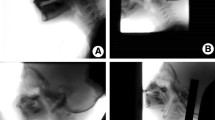Abstract
Videofluoroscopic swallowing study (VFSS) is generally used to diagnose dysphagia and oropharyngeal aspiration during swallowing movement. Patients and bolus-feeding operators (such as occupational therapist and speech language pathologist) may undergo multiple VFSS procedure, placing them at risk for more radiation exposure due to increased scan time. The present study investigated the dose–area product, effective dose of various protocols, and summarized dose reports from various studies of VFSS. The PubMed database searched for relevant publications reporting radiation dose in the VFSS procedure. 13 articles were selected to be reviewed. This systematic review involved 13 peer-reviewed articles that reported the specific dose of the VFSS procedure. The articles were categorized into three types: operator radiation dose, adult patient radiation dose, and pediatric radiation dose. The operator dose reports showed that the operators’ scattering exposure, equivalent dose (across the whole body, eyes, and hands), and annual effective dose were significantly lower than the annual dose limit of 20 mSv. Both adult and pediatric patient dose reports showed that the effective dose, which was estimated from recorded dose–area product, was significantly lower than the annual background exposure of 2.4 mSv in various protocols. The present literature review suggested that the radiation dose of VFSS by modified barium swallowing is acceptable in both operators and patients. However, various radiation protection strategies should be conducted during the procedure to reduce the risk of stochastic effect.

Similar content being viewed by others
Change history
05 November 2020
The original version of this article unfortunately contained a mistake. The presentation of Fig. 1 was incorrect. The correct version of Fig. 1 is given below.
References
Logemann JA. The evaluation and treatment of swallowing disorders. Curr Opin Otolaryngol Head Neck Surg. 1998;6:395–400.
Han TR, Paik NJ, Park JW. Quantifying swallowing function after stroke: a functional dysphagia scale based on videofluoroscopic studies. Arch Phys Med Rehabil. 2001;82:677–82. https://doi.org/10.1053/apmr.2001.21939.
Martin-Harris B, Jones B. The videofluorographic swallowing study. Phys Med Rehabil Clin N Am. 2008;19:769–85. https://doi.org/10.1016/j.pmr.2008.06.004.
Dainiak N. Radiation dose and stochastic risk from exposure to medical imaging. Chest. 2013;144:1431–3. https://doi.org/10.1378/chest.13-1064.
Chan CB, Chan LK, Lam HS. Scattered radiation level during videofluoroscopy for swallowing study. Clin Radiol. 2002;57:614–6. https://doi.org/10.1053/crad.2001.0904.
Morishima Y, Chida K, Watanabe H. Estimation of the dose of radiation received by patient and physician during a videofluoroscopic swallowing study. Dysphagia. 2016;31:574–8. https://doi.org/10.1007/s00455-016-9718-6.
Crawley MT, Savage P, Oakley F. Patient and operator dose during fluoroscopic examination of swallow mechanism. Br J Radiol. 2004;77:654–6. https://doi.org/10.1259/bjr/22832251.
Hayes A, Alspaugh JM, Bartelt D, Campion MB, Eng J, Gayler BW, Henkel SE, Jones B, Lingaraj A, Mahesh M, Rostkowski M, Smith CP, Haynos J. Radiation safety for the speech-language pathologist. Dysphagia. 2009;24:274–9. https://doi.org/10.1007/s00455-008-9201-0.
Weir KA, McMahon SM, Long G, Bunch JA, Pandeya N, Coakley KS, Chang AB. Radiation doses to children during modified barium swallow studies. Pediatr Radiol. 2007;37:283–90. https://doi.org/10.1007/s00247-006-0397-6.
Hersh C, Wentland C, Sally S, de Stadler M, Hardy S, Fracchia MS, Liu B, Hantnick C. Radiation exposure from videofluoroscopic swallow studies in children with a type 1 laryngeal cleft and pharyngeal dysphagia: a retrospective review. Int J Pediatr Otorhinolaryngol. 2016;89:92–6. https://doi.org/10.1016/j.ijporl.2016.07.032.
Sulieman A, Elhag B, Alkhorayerf M, Babikir E. Estimation of effective dose and radiation risk in pediatric barium studies procedures. Appl Radiat Isot. 2018;138:40–4. https://doi.org/10.1016/j.apradiso.2017.07.013.
Zammit-Maempel CCL, Leslie P. Radiation dose in videofluoroscopic swallow studies. Dysphagia. 2007;22:13–5. https://doi.org/10.1007/s00455-006-9031-x.
Chau KHT, Kung CMA. Patient dose during videofluoroscopy swallowing studies in a Hong Kong public hospital. Dysphagia. 2009;24:387–90. https://doi.org/10.1007/s00455-009-9214-3.
Kim HM, Choi KH, Kim TW. Patients’ radiation dose during videofluoroscopic swallowing studies according to underlying characteristics. Dysphagia. 2013;28:153–8. https://doi.org/10.1007/s00455-012-9424-y.
Ko EJ, Sung IY, Choi KH, Kwon YG, Yoon J, Kim T. Radiation exposure during videofluoroscopic swallowing studies in young children. Int J Pediatr Otorhinolaryngol. 2019;121:1–5. https://doi.org/10.1016/j.ijporl.2019.02.038.
Im HW, Kim SY, Oh BM, Han TR, Seo HG. Radiation Dose During Videofluoroscopic Swallowing Studies and Associated Factors in Pediatric Patients. Dysphagia. 2019. https://doi.org/10.1007/s00455-019-10006-z.
Khursheed A, Hillier MC, Shrimpton PC, Wall BF. Influence of patient age on normalized effective doses calculated for CT examinations. Br J Radiol. 2002;75:819–30. https://doi.org/10.1259/bjr.75.898.750819.
McLean D, Malitz N, Lewis S. Survey of effective dose levels from typical paediatric CT protocols. Australas Radiol. 2003;47:135–42. https://doi.org/10.1046/j.0004-8461.2003.01141.x.
Chapple CL, Willis S, Frame J. Effective dose in paediatric computed tomography. Phys Med Biol. 2002;47:107–15. https://doi.org/10.1088/0031-9155/47/1/308.
Peladeau-Pigeon M, Steele CM. Technical aspects of a videofuoroscopic swallowing study. Can J Speech Lang Pathol Audiol. 2013;37:216–26.
Mercado-Deane M-G, Burton EM, Harlow SA, Glover AS, Deane DA, Guill MF, Hudson V. Swallowing dysfunction in infants less than 1 year of age. Pediatr Radiol. 2001;31:423–8. https://doi.org/10.1007/s002470100456.
Cohen MD. Can we use pulsed fuoroscopy to decrease the radiation dose during video fluoroscopic feeding studies in children? Clin Radiol. 2009;64:70–3. https://doi.org/10.1016/J.Crad.2008.07.011.
Hiorns MP, Ryan MM. Current practice in paediatric videofluoroscopy. Pediatr Radiol. 2006;36:911–9. https://doi.org/10.1007/s00247-006-0124-3.
Hill F, Keane J, Flynn E, Gallagher R, Farrell E, Murphy M. Clinical Variables Influencing Screening Time During Videofluoroscopy. Dysphagia. 2014;29:144.
Bibbo G, Balman D, Linke R. Diagnostic reference levels for common paediatric fluoroscopic examinations performed at a dedicated paediatric Australian hospital. Journal of medical imaging and radiation oncology. 2016;60(4):469–74.
Mulheren RW, Azola A, González-Fernández M. Do ratings of swallowing function differ by videofluoroscopic rate? An exploratory analysis in patients after acute stroke. Arch Phys Med Rehabil. 2019;100(6):1085–90.
Bonilha HS, Blair J, Carnes B, Huda W, Humphries K, McGrattan K, Martin-Harris B. Preliminary investigation of the effect of pulse rate on judgments of swallowing impairment and treatment recommendations. Dysphagia. 2013;28(4):528–38.
Acknowledgements
This work was supported by Dongseo University, “Dongseo Cluster Project” Research Fund of 2020.
Author information
Authors and Affiliations
Corresponding authors
Ethics declarations
Conflict of interest
The author claims no conflicts of interest.
Additional information
Publisher's Note
Springer Nature remains neutral with regard to jurisdictional claims in published maps and institutional affiliations.
Rights and permissions
About this article
Cite this article
Hong, JY., Hwang, NK., Lee, G. et al. Radiation Safety in Videofluoroscopic Swallowing Study: Systematic Review. Dysphagia 36, 73–82 (2021). https://doi.org/10.1007/s00455-020-10112-3
Received:
Accepted:
Published:
Issue Date:
DOI: https://doi.org/10.1007/s00455-020-10112-3




